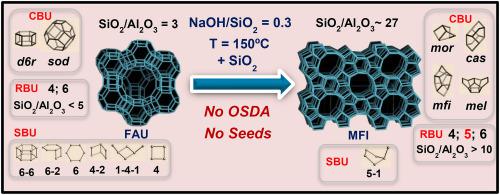Microporous and Mesoporous Materials ( IF 4.8 ) Pub Date : 2020-07-03 , DOI: 10.1016/j.micromeso.2020.110413 Mauricio B. dos Santos , Kim C. Vianna , Heloise O. Pastore , Heloysa M.C. Andrade , Artur J.S. Mascarenhas

|
In this work, a study of the interzeolite transformation from a parent zeolite Y (FAU topology) into zeolite ZSM-5 (MFI topology) was carried out, without using organic structure directing agents, by addition of SiO2 to adjust the composition of the starting gel. Depending on the SiO2/Al2O3 molar ratio, zeolite Y can be present in amounts equivalent to those of seed-assisted syntheses. Zeolite Y was successfully transformed in ZSM-5, but a rigorous control of OH−/SiO2 and Na+/SiO2 molar ratios is necessary to avoid incomplete transformation and/or contamination by layered silicates, such as magadiite and kenyaite. For hydrothermal treatment duration lesser than 12 h, the phase dissolution of the Y zeolite is observed, resulting in amorphous phase after 24 h. From 48 h, nucleation and growth of ZSM-5 crystals, with increasing crystallinity up to 120 h, is observed. During the interzeolite transformation, FTIR spectra show the disappearance of the band at 568 cm−1 and the appearance of a band at 545 cm−1, assigned to the 5-membered double rings of ZSM-5. Scanning electron microscopy images suggest that the crystallites of zeolite Y condense and absorb silicate species from solution to form larger aggregates of ZSM-5 zeolite. These structural and morphological changes are accompanied by textural changes detected in nitrogen adsorption isotherms. These results suggested that a combined solution mediated and solid-state transformation mechanism is probably occurring. Since these zeolites do not possess any other structural features in common, RBU approach seems to be more adequate to describe this specific interzeolite transformation.
中文翻译:

在不使用有机结构导向剂的情况下,由Y型分子筛转变为ZSM-5的研究
在这项工作中,通过添加SiO 2来调节分子筛的组成,研究了从母体Y(FAU拓扑)到ZSM-5(MFI拓扑)沸石之间的沸石间转变。起始胶。取决于SiO 2 / Al 2 O 3的摩尔比,沸石Y可以以与种子辅助合成的那些相同的量存在。沸石Y是成功转化在ZSM-5,但OH的严格控制- /二氧化硅2和Na + /二氧化硅2为了避免不完全的转变和/或被层状硅酸盐如magadiite和kenyaite污染,摩尔比是必要的。对于小于12小时的水热处理时间,观察到Y沸石的相溶解,在24小时后导致非晶相。从48小时开始,观察到ZSM-5晶体的成核和生长,随着结晶度的增加,直至120小时。在沸石间转变过程中,FTIR光谱显示在568 cm -1处谱带消失,在545 cm -1处谱带出现。,分配给ZSM-5的5元双环。扫描电子显微镜图像表明,沸石Y的晶体会凝聚并吸收溶液中的硅酸盐物质,从而形成更大的ZSM-5沸石聚集体。这些结构和形态变化伴随着在氮吸附等温线中检测到的纹理变化。这些结果表明,可能会发生结合溶液介导的固态转化机理。由于这些沸石没有其他共同的结构特征,因此RBU方法似乎更适合描述这种特定的沸石间转变。









































 京公网安备 11010802027423号
京公网安备 11010802027423号